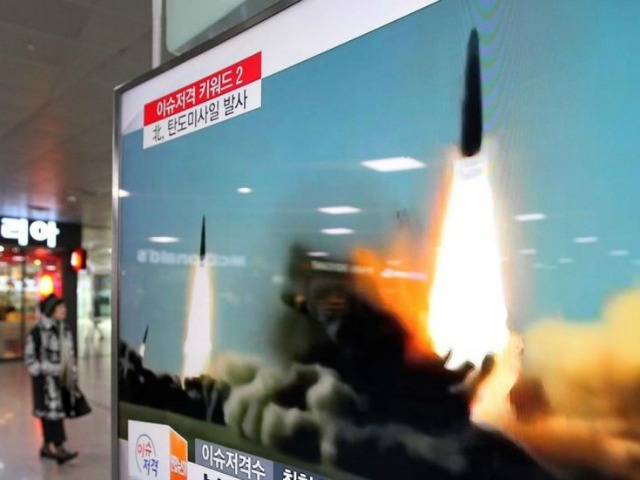North Korea once again threatened American military and civilians on the island of Guam on Tuesday, describing its outrageous launch of a missile over Japan as a “meaningful prelude to containing Guam, an advanced base of invasion.”
A translation of dictator Kim Jong-un’s remarks on North Korean state media by the Associated Press has the dictator describing the Japan missile shot as “the first step of the military operation in the Pacific.”
He vowed to “push forward the work for putting the strategic force on a modern basis by conducting more ballistic rocket launching drills with the Pacific as a target in the future.”
Kim’s description of Guam as an “advanced base of invasion” is most likely a reference to the American B-1B bombers based there. North Korea constantly denounces B-1B flights near the Korean border.
Kim Jong-un also described its recent missile launches as “a curtain-raiser of its resolute countermeasures” against the joint U.S.-South Korea military exercise currently in progress. North Korea and its patron China consider these exercises provocative dress rehearsals for an invasion, or possibly cover for an actual invasion launched under the pretext of conducting military exercises.
The Associated Press speculates that Kim decided to portray the Japan missile shot as a response to the U.S.-South Korean military drill because China has been calling for suspension of the drills as part of a deal to halt North Korean missile and nuclear testing. In other words, China’s rhetoric and political support have emboldened the psychotic North Korean regime to launch missiles into foreign airspace and make demands.
Kim essentially said as much by declaring he would “show action, not talk, to the U.S. imprudently denying the initiative measures for easing the extreme tension” on the Korean peninsula. This is a way of saying provocations will escalate until North Korea’s demands are met.
North Korean officials told CNN they were “very satisfied with the performance” of the “ultra-modern rocket system” they launched at Japan.
CNN quotes South Korean President Moon Jae-in and Japanese Prime Minister Shinzo Abe stating that “pressure on North Korea should be raised to its limit so that North Korea will voluntarily come to the table for dialogue,” as a Moon spokesman put it. That is the exact inverse of Kim’s belief that ratcheting up North Korean provocations will force the U.S. and its allies to come to the table in a weak bargaining position.
President Donald Trump weighed in on Twitter Wednesday, as is his custom:
Guam’s government was stoic in the face of renewed North Korean threats. “We knew, based on North Korea events in previous years, that with the joint exercise between the US, South Korea, and its Allies, we can expect rhetoric and activity in North Korea,” said George Charfauros, homeland security adviser to Governor Eddie Calvo.
“It is important to remember that the U.S. Department of Defense capabilities are more than competent and stand ready to defend the U.S., its territories, and Allies,” Charfauros said.
Governor Calvo released a video message on Tuesday declaring “the people of Guam are safe, and we continue to do business as usual”:
Calvo stated that Guam’s threat level was not increased after North Korea’s latest threats. He did, however, remind residents to make sure they have proper emergency kits packed and disaster plans laid out, as a general precaution.
The U.N. Security Council “strongly condemned” North Korea’s “outrageous” missile launch over Japan in an emergency meeting on Tuesday, but did not specify any additional sanctions against Pyongyang.
The United States successfully intercepted a medium-range ballistic missile off the coast of Hawaii on Wednesday, in what defense officials described as a “long planned” test that might nevertheless send a useful message to North Korea.
The intercept was performed by an SM-6 fired from the Arleigh Burke-class guided missile destroyer USS John Paul Jones. The test involved new targeting software designed by Raytheon, which said it was able to accomplish two years’ worth of coding and testing in about seven months. It was the third successful test of an SM-6 against a medium-range ballistic missile. Use of the system against a North Korean weapon would require a high degree of coordination between the American, South Korean, and Japanese navies.

COMMENTS
Please let us know if you're having issues with commenting.